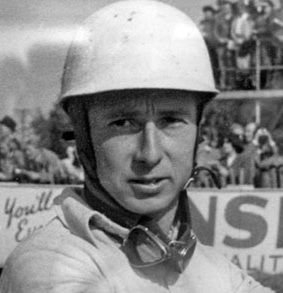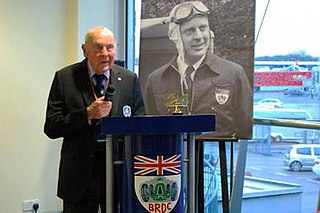
Hersham and Walton Motors (HWM) is the world's longest established Aston Martin business, having acquired the franchise in 1951. As a racing car constructor, HWM competed in Formula One and Formula Two, and in sports car racing.

Hersham and Walton Motors (HWM) is the world's longest established Aston Martin business, having acquired the franchise in 1951. As a racing car constructor, HWM competed in Formula One and Formula Two, and in sports car racing.
Hersham and Walton Motors was founded in 1938 by John Heath, an excellent race driver and talented engineer. Heath was joined by George Abecassis in 1946. Together, they moved the business into a building based on New Zealand Avenue in Walton on Thames which was previously used by Vickers during the war as part of their aircraft construction facility. [1]
George Abecassis and John Heath went racing together from 1946 and in 1948 they built a streamlined sports racing car on the chassis of a Sports Alta, and thus embarked upon the construction of racing cars and racing sports cars at the Walton-on-Thames works. The 1948 car gave them encouraging results and so new car, this time called an HW-Alta, was constructed and raced in 1949; this car was sufficiently successful to convince the partners to embark upon building a full team of cars for the 1950 Formula Two season of British and continental events: these cars were known as HWMs.
They were the first British team to find international success after WW2 which is almost forgotten. The operated with a very limited budget from their little garage in Walton-on-Thames. Over HWM's seven-year life as a racing car manufacturer less than two dozen were built, but some 70 per cent of the entire production survives today.

The HWM leadership had a skill for spotting young talent. There is a remarkable list of drivers that raced for the team including Duncan Hamilton, Peter Collins, Harry Schell, Lance Macklin and Paul Frère. This list is far from exhaustive but perhaps the most famous name was that of Stirling Moss. Before driving for HWM, Stirling was a privateer racing a Cooper. He was offered his first professional drive at HWM and went on to race for the team for nearly two years. His talent helped the team to gain results that were beyond expectation.[ citation needed ]
The HWM's four-cylinder Alta engine lacked the power of most of its rivals, but its all-independent chassis handled well, and Stirling's budding genius exploited it to the full. He finished third at Reims behind Ascari's Ferrari and Simon's Gordini, and, unbelievably, third in the F1 race at Bari behind the 159 Alfas of Farina and Fangio. He set fastest lap in the Rome Grand Prix chasing the F2 Ferraris of Ascari and Villoresi, and was leading the Naples Grand Prix when he was pushed off into a tree by a backmarker. Johnny Claes, meanwhile, scored the first post-war win by a British car in a race titled as a Grand Prix when he won the Belgian Grand Prix des Frontières at Chimay, while Lance Macklin was sixth in the German Grand Prix and Rudi Fischer was sixth at Berne. [2]
In between, there were blown engines to rebuild and bent cars to repair, the hard-pressed transporters frequently broke down, one of the racers caught fire the night before a race, and one of the mechanics, plus car and van, got lost in the middle of Italy, without money and unable to speak a word of Italian. But the team made it to the end of the season, and with good enough results to have built a substantial reputation across Europe. Most important of all, once the three cars were sold off after the last race, there was a small profit to show for all that toil.
Of those three 1950 works cars, one has remained in its Alta-engined form. Another was given a Jaguar XK120 engine by its new owner Oscar Moore, becoming the first in a long line of Jaguar-powered specialist sports-racers. And the third ended up in Hollywood, starring in a movie with Kirk Douglas, before gaining a Chevrolet V8 engine and going on to a second racing career on the USA's West Coast as the Stovebolt Special. All three now live with enthusiastic owners in England.[ citation needed ]

From 1950 to 1952, HWM achieved remarkable success in Formula Two for a team that was run on very little money and yet which faced the might of continental marques in every race. By 1953 they were outclassed, but when the international Formula changed in 1954, John Heath constructed a works car to compete in Formula One. Right from the first event, the non-championship Lavant Cup at Goodwood, the new car proved to be off the pace. It retired from the BRDC International Trophy and then came its World Championship debut at the French Grand Prix at Reims-Gueux. Macklin qualified a whole 23 seconds behind Juan Manuel Fangio and was running last when the engine failed. With that, HWM abandoned their Formula One programme. [3]
Meanwhile, the first Jaguar-engined HWM sports racing car had appeared in 1953, and this had some success with Abecassis at the wheel. From then on until 1957, the team was involved in sports car racing both in Britain and on the continent, sometimes beating their Jaguar and Aston Martin Works competitors. After John Heath was killed on the 1956 Mille Miglia in Italy in an HWM Works car, Abecassis did not wish to continue and the works racing programme continued for just a year.
In 1950 George Abecassis had won his class at Le Mans in an Aston Martin DB2 with co-driver Lance Macklin. This cemented George's relationship with Aston Martin and the following year HWM was awarded the Aston Martin franchise. It remains an Aston Martin dealership to this day. Having been extremely impressed by Lance Macklin's driving performance at Le Mans, George also secured Lance for the HWM team. Lance went on to be one HWM's most loyal drivers.
In 1958, Mike Harting arrived at HWM as a partner to George Abecassis. He had previously been the global sales manager for Aston Martin at their Feltham facility five miles away from the Walton dealership.
One of those contacts was George Abecassis. George had been running the business on his own since the death of John Heath but was keeping an eye out for a suitable partner. As an Aston Martin Works racing driver, George had struck up a relationship with Mike Harting. It became apparent that there was potential to work together. Mike wanted a career that required him to travel less and therefore see more of his family. The HWM business looked like an attractive option so the deal was agreed and they joined forces.
Eventually when George retired, Mike took ownership of the whole of the HWM business and continued at the helm, later joined by his son Andrew, through the rest of his life.
HWM is today owned by Andrew Harting and the Harting family along with Guy Jenner. HWM trades as HWM Aston Martin and HWM Sports Cars and is an Aston Martin and Sports Cars dealership. It is the oldest Aston Martin dealership in the world.[ citation needed ]
(key) (results in bold indicate pole position; results in italics indicate fastest lap)
| Year | Chassis | Engine | Tyres | Driver | 1 | 2 | 3 | 4 | 5 | 6 | 7 | 8 | 9 |
|---|---|---|---|---|---|---|---|---|---|---|---|---|---|
| 1951 | HWM 51 | Alta 2.0 L4 | D | SUI | 500 | BEL | FRA | GBR | GER | ITA | ESP | ||
| | Ret | ||||||||||||
| | 8 | ||||||||||||
| 1952 | HWM 51 HWM 52 | Alta 2.0 L4 | D | SUI | 500 | BEL | FRA | GBR | GER | NED | ITA | ||
| | Ret | ||||||||||||
| | Ret | Ret | 6 | Ret | DNS | DNQ | |||||||
| | Ret | 11 | 9 | 15 | 8 | DNQ | |||||||
| | Ret | ||||||||||||
| | 5 | Ret | |||||||||||
| | 12 | ||||||||||||
| | 10 | ||||||||||||
| | Ret | 7 | |||||||||||
| | 10 | ||||||||||||
| | NC | ||||||||||||
| 1953 | HWM 53 | Alta 2.0 L-4 | P | ARG | 500 | NED | BEL | FRA | GBR | GER | SUI | ITA | |
| | 8 | Ret | 13 | Ret | |||||||||
| | Ret | Ret | Ret | Ret | Ret | Ret | |||||||
| | 10 | Ret | |||||||||||
| | 14 | 15 | |||||||||||
| | Ret | ||||||||||||
| | Ret | ||||||||||||
| | NC | ||||||||||||
| | Ret | ||||||||||||
| 1954 | HWM 53 | Alta 2.5 L-4 | D | ARG | 500 | BEL | FRA | GBR | GER | SUI | ITA | ESP | |
| | Ret | ||||||||||||
| Source [4] | |||||||||||||
(key) (Results in bold indicate pole position; results in italics indicate fastest lap.)
| Year | Entrant | Chassis | Engine | Driver | 1 | 2 | 3 | 4 | 5 | 6 | 7 | 8 |
|---|---|---|---|---|---|---|---|---|---|---|---|---|
| 1952 | Tony Gaze | HWM 51 HWM 52 | Alta 2.0 L-4 | SUI | 500 | BEL | FRA | GBR | GER | NED | ITA | |
| | 15 | Ret | Ret | DNQ | ||||||||
| 1955 | E. N. Whiteaway | HWM 54 | Alta 2.5 L-4 | ARG | MON | 500 | BEL | NED | GBR | ITA | ||
| | DNQ | |||||||||||
The Alta Car and Engineering Company was a British sports and racing car manufacturer, commonly known simply as Alta. Their cars contested five FIA World Championship races between 1950 and 1952, as well as Grand Prix events prior to this. They also supplied engines to a small number of other constructors, most notably the Connaught and HWM teams.

George Edgar Abecassis was a British racing driver, and co-founder of the HWM Formula One team.

The 1952 Swiss Grand Prix was a Formula Two race held on 18 May 1952 at Bremgarten Circuit. It was the first round of the 1952 World Championship of Drivers, in which each Grand Prix was run to Formula Two rules rather than the Formula One regulations normally used.

The 1952 French Grand Prix was a Formula Two race held on 6 July 1952 at Rouen-Les-Essarts. It was race 4 of 8 in the 1952 World Championship of Drivers, in which each Grand Prix was run to Formula Two rules rather than the Formula One regulations normally used. Unusually this race was run over a duration of 3 hours, rather than a fixed distance.

Peter John Collins was a British racing driver. He was killed in the 1958 German Grand Prix, just weeks after winning the RAC British Grand Prix. He started his career as a 17-year-old in 1949, impressing in Formula 3 races, finishing third in the 1951 Autosport National Formula 3 Championship.

Roy Francesco Salvadori was a British racing driver and team manager. He was born in Dovercourt, Essex, to parents of Italian descent. He graduated to Formula One by 1952 and competed regularly until 1962 for a succession of teams including Cooper, Vanwall, BRM, Aston Martin and Connaught. Also a competitor in other formulae, he won the 1959 24 Hours of Le Mans in an Aston Martin with co-driver Carroll Shelby.

Lance Noel Macklin was a British racing driver from England. He participated in 15 Formula One World Championship Grands Prix, debuting on 18 May 1952. He was infamously involved in the 1955 Le Mans disaster, starting the initial chain reaction.

Peter Nield Whitehead was a British racing driver. He was born in Menston, Yorkshire and was killed in an accident at Lasalle, France, during the Tour de France endurance race. A cultured, knowledgeable and well-travelled racer, he was excellent in sports cars. He won the 1938 Australian Grand Prix, which along with a 24 Heures du Mans win in 1951, probably was his finest achievement, but he also won two 12 Heures internationales de Reims events. He was a regular entrant, mostly for Peter Walker and Graham Whitehead, his half-brother. His death in 1958 ended a career that started in 1935 – however, he was lucky to survive an air crash in 1948.
John Eric George "Jack" Fairman was a British racing driver from England. He participated in 13 Formula One Grands Prix, making his debut on 18 July 1953. He scored a total of five championship points, all of which came in the 1956 season.

The Aston Martin DB2 is a grand tourer that was sold by Aston Martin from May 1950 until April 1953. The successor to the 2-Litre Sports model, it had a comparatively advanced dual overhead cam 2.6 L Lagonda straight-6 engine in place of the previous overhead valve engine straight-four engine. It was available as a closed, 2-seater coupé which Aston Martin called a sports saloon, and later also as a drophead coupé, which accounted for a quarter of the model's total sales. The closed version had some success in racing.

Peter Douglas Conyers Walker was an English racing driver. He was born in Huby, Yorkshire and died in Newtown, Worcestershire. He proved a strong driver in most disciplines, but was most adept in sports cars, winning the 1951 24 Hours of Le Mans race, and the Goodwood Nine-Hours in 1955. He effectively retired after a crash in 1956 left him with serious injuries.

Eric David Thompson was a British racing driver, book dealer and insurance broker. He participated in sports car racing between 1949 and 1955 taking his greatest success by finishing third in the 1951 Les 24 Heures du Mans and took part in the 1952 RAC British Grand Prix.

The 1955 24 Hours of Le Mans was the 23rd 24 Hours of Le Mans and took place on 11 and 12 June 1955 on Circuit de la Sarthe. It was also the fourth round of the F.I.A. World Sports Car Championship. During the race, a crash killed driver Pierre Levegh and 83 spectators while injuring 120 others in the deadliest accident in motor racing history.

The 1953 24 Hours of Le Mans was the 21st Grand Prix of Endurance, and took place on 13 and 14 June 1953, at the Circuit de la Sarthe, Le Mans (France). It was also the third round of the F.I.A. World Sports Car Championship.

The 1950 24 Hours of Le Mans was a motor race for sports cars, staged at the Circuit de la Sarthe, Le Mans, France on 24 and 25 June 1950. It was the 18th Grand Prix of Endurance. The race was won by the French father-and-son pairing of Louis and Jean-Louis Rosier driving a privately entered Talbot-Lago.

Aix-les-Bains, Savoie, France had a race track, called Circuit du Lac, which hosted Formula 2, Formula Junior, and Motorcycle Grand Prix races between 1949 and 1960.

Racing Point F1 Team, which competed as BWT Racing Point F1 Team and commonly known as Racing Point, was a British motor racing team and constructor that Racing Point UK entered into the Formula One World Championship. The team was based in Silverstone, England and competed under a British licence.

Aston Martin is a British car manufacturer that has participated in Formula One in various forms and is currently represented by a team named as Aston Martin Aramco F1 Team. The company first participated in Formula One during the 1959 season, where they debuted the DBR4 chassis using their own engine, but it failed to score any points. They continued to perform poorly through the 1960 season, once again failing to score any points. As a result, Aston Martin decided to leave Formula One after 1960.
The HWM 51 was an open-wheel race car, designed by Briton John Heath, and developed and built by HWM, in 1951. It competed in voiturette racing events, as well as two Formula One World Championship Grand Prix events; the 1951 Swiss Grand Prix, and the 1952 Belgian Grand Prix.
Abecassis, David (2010). A Passion For Speed, the Life and Times of George Abecassis. Paul Skilleter Books. ISBN 978-0-9566857-0-4.
Taylor, Simon (2019). John, George and the HWMs. Evro Publishing. ISBN 978-1-9105053-2-8.